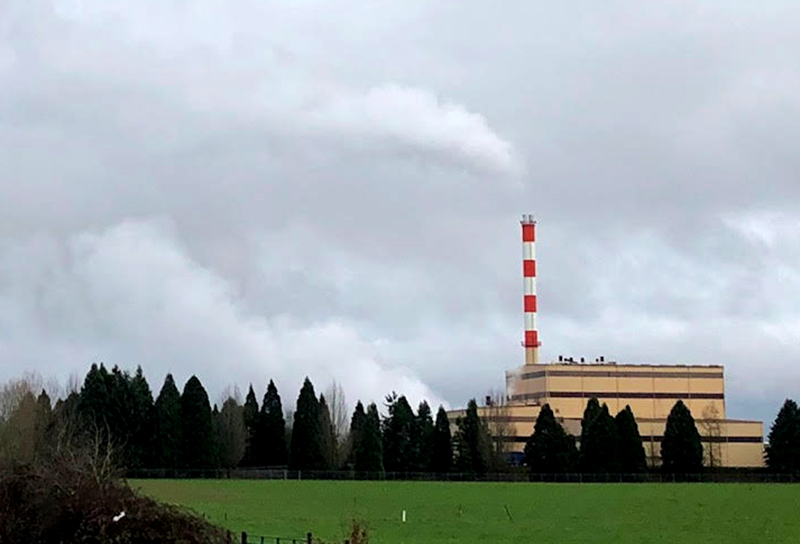Covanta Marion Garbage, Industrial and Medical Waste Incinerator

Covanta Marion waste incinerator in Brooks, Oregon.
What is Covanta Marion?
Covanta Marion may be Oregon’s only garbage incinerator, but Covanta is an international corporation with approximately 40 incinerators in other parts of the United States, the United Kingdom, Canada and Europe. The incinerator in Oregon, built in 1986, is one of the oldest, most out-of-date and polluting facilities. It burns an assortment of waste products to produce 13 megawatts of electricity. Covanta is among Oregon’s most dangerous polluters. The incinerator produces highly toxic air emissions from its stacks and toxic-laden ash that is hauled away and dumped on land. The Oregon Department of Environmental Quality determined that high levels of mercury in the Willamette River are associated with the waste water that Covanta Marion discharges directly into the river.
Burning much more than a city’s garbage!
Covanta burns municipal garbage from Marion County. However, the facility increases their profits by importing medical waste and industrial waste from other states, sometimes as far away as Georgia. In June 2021, the Salem Statesman-Journal reported that Covanta Marion burns unexpected waste streams like body parts, vinyl plastic, toner cartridges, oily solids, HVAC filters, polyurethane foam and Styrofoam peanuts, empty hazardous waste containers and pharmaceutical waste. These inputs, when burned, create dioxins (the hazardous contaminant in Agent Orange), heavy metals such as lead, cadmium and mercury, as well as hydrogen chloride. Covanta Marion is the 19th single largest source of greenhouse gasses in Oregon.
Our History of Clean Air Advocacy
Covanta Marion and its pollution has been an important focus of our clean air advocacy since 2018. Currently, the facility is required to get a Title V air pollution discharge permit under the Cleaner Air Oregon regulatory program, a type of regulatory permit reserved for the largest polluters. In our role as a clean air watchdog, Beyond Toxics advocates for policies and regulations that protect downwind communities from Covanta Marion’s high level of toxic pollution and require upgrades to its outdated equipment. First, we released the first moss study of heavy metal pollution near Covanta. Our results showed that there were higher concentrations of heavy metals in areas closest to the incinerator, which we surmise is due to fallout from the plume of air pollution emitted from the incinerator’s stacks.
Beyond Toxics played a major role to stop SB 451 in 2019, which was introduced at the request of Covanta in order to designate the incinerator as a “renewable” energy facility. This would have allowed Covanta to falsely greenwash its practice of incinerating garbage as renewable energy, profit from renewable energy tax credits, and sell the generated electricity at a higher rate.
Current Legislative Victory
Beyond Toxics championed Oregon Senate Bill 488, sponsored by Senator Patterson and supported by several legislators, which became law after passing both chambers of the 2023 Oregon Llegislature. This groundbreaking legislation centers around municipal solid waste incinerators, promising transparent, accurate and publicly available data on toxic emissions from waste incineration. It also places firm limits on the amount of medical waste burned at incinerators in Oregon.
Significance for Oregonians
Prior to the passage of SB 488, incinerator owners only tested for dioxins and heavy metals once a year during pre-arranged visits from the Oregon DEQ. Now Covanta Marion will be required to sample for heavy metals and other hazardous chemicals on a continuous schedule (by minute and/or by hour) and report these toxic pollutants to the public. This victory achieves cleaner air, polluter transparency, and the adoption of the most up-to-date technology, showcasing Oregon's commitment to a healthier environment. SB 488 mandates one of the only continuous emissions monitoring projects in the United States, and provides a model for other facilities to follow in the future. The passage of this law upholds our long commitment to the principle of Toxics Right to Know -- communities have a right to know what’s in the air they breathe!
Continuing the Fight For Clean Air
Oregon Senate Bill 488, passed in the 2023 legislative session, requires Covanta to submit a draft sampling plan to the Oregon DEQ by the end of 2023. Unfortunately, the plan was deemed to be inadequate by the DEQ. The test plan did not include a plan to continuously monitor or sample for PCBs, dioxins/furans, cadmium, lead, mercury, arsenic, total chromium, manganese, nickel, selenium, and zinc. The DEQ sent Covanta a Warning Letter With Opportunity to Correct which established January 25th as the new target date for them to submit a complete plan. As of April 1, Covanta has still not submitted their legally-required sampling plan.
Resources
To learn more about what we are doing to address and reduce the harmful air toxics emitted from Covanta, review below a small selection of our research, environmental monitoring reports, blogs and public testimony submitted to the Department of Environmental Quality. News articles can be found on our In the News resources page.






